Text
“Only wine is suited to reminiscence. A good wine allows clarity and focus, while still allowing a bit of comforting coloration of the memory.”
- Kvothe, The Name of the Wind, p. 470
2 notes
·
View notes
Text
Two years later.
It’s been almost two years since I’ve posted on this blog. I’ve enjoyed maintaining this little plot of cyberland, but will say I’ve found it increasingly difficult to prioritize creating – writing – over the past years. Shall we blame it on social media, responsible for incessantly ramming insipid details and curated images into the brain? Why yes, we could do that. The glut of self-promoting…

View On WordPress
1 note
·
View note
Text
I came to Costa Rica to escape frost.
It was February, and I had left behind a Massachusetts in which every particle and every follicle was laced with frost, brimming with frost, encrusted with frost. But here in Costa Rica I stood with my friends, gawking at…frost.
I was not impressed.
When you’re traveling in Costa Rica with Costa Ricans, though, frost has a novelty all of its own. You don’t expect a country 10 degrees north of the Equator to be reaching south of zero degrees in temperature. Which brings us back to why at 4am I was gathered with my friends around this mound of frosted moss, photographing it, posing with it, and squealing with glee about it.
Oh look, more…frost.
Lest you be concerned, seeing frost was not our primary mission (well, I’ll speak for myself). We were summiting Cerro Chirripó, the tallest peak in Costa Rica at 3,821 meters. The trail beginning in San Gerardo de Rivas (the most popular starting point) is well-marked, though steep and somewhat strenuous at parts. SINAC (National System of Conservation Areas, in English) limits the number of permits available to enter Chirripó National Park each day, so for much of the hike, we marched to the tune of our own footsteps and haggard breathing. And the majority of those people we did encounter were ticos, which I loved. Having lived over two years in Costa Rica, hiking Chirripó had been festering on my bucket list – and I had the most sublime time crossing it off.
Timetable
Chirripó National Park encompasses five ecosystems, and should be a multi-day experience for anyone who actually wants to enjoy it (biased opinion). Exhibit A: We did meet a deranged couple in San Gerardo who ascended and descended all in one day, but they candidly admitted they felt like they were dying. Here’s our timetable, which I’d recommend for maximum enjoyment of all there is to see at the top:
Day 1: Travel to San Gerardo.
Travel to San Gerardo de Rivas & check in with SINAC offices by 4pm. Night in San Gerardo de Rivas.

Day 2: Hike San Gerardo – Crestones Base Camp.
Begin climb at 3am from San Gerardo to Crestones Base Camp (we totaled 7.5 hours – average time is 8 hours). Night at Crestones.

Day 3: Summit Cerro Chirripó for the sunrise…
Begin ascent at 3am from Crestones Base Camp to see sunrise on Cerro Chirripo (approximately 2 hours hiking). After sunrise, hike to Los Crestones, via Valle de los Conejos. Total 8 hours hiking. Night at Crestones.

…& then hike to Los Crestones.
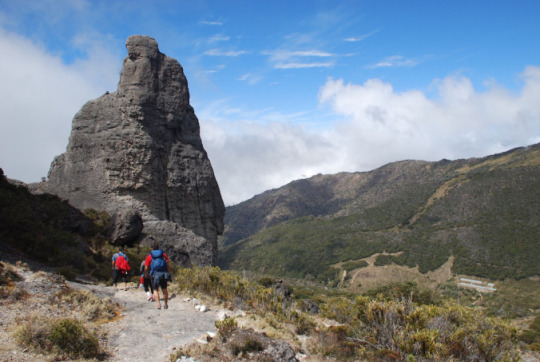
Day 4: Descend from Crestones Base Camp – San Gerardo.
Descend from Crestones Base Camp to San Gerardo (~4.5 hours for our group).

Sights from the summit
Where to stay
San Gerardo de Rivas (night before ascent)
We stayed at Hotel Urán, which provided perfectly good, clean, basic accommodations. A private room with bunk beds and shared bathrooms cost us ~$21 each, and the hotel included breakfast – which they kindly packed and bagged for us the night before our ascent to eat along the way. The best thing about this hotel was definitely the location – the entrance to Parque Nacional Chirripó is maybe 1 minute walking up the road. Casa Mariposa, located right next door, also has a great location (though a bit pricier). If you’re staying elsewhere, remember to inquire about what transportation is available to get you to the trailhead (especially if you’re beginning your ascent early).
Crestones Base Camp
This’ll make it easy – this is your only lodging choice. Clean, simple, chilly. Rooms of two bunk beds apiece (hostel-style), shared bathrooms, and ICE COLD SHOWERS (<– yes.). Make sure you buy meals in advance. Hiking around Chirripó will take your butt and freeze it and if you do not sign up to eat hot meals I do not know how you think you’re going to thaw it. The meals are expensive…but remember that horses and humans lugged your uncooked calories up the mountain on their backs and then complain.
Tips
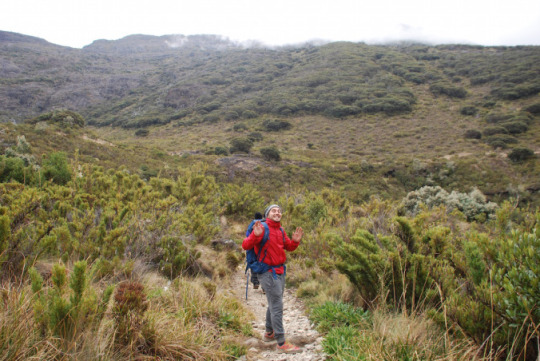
Start booking your spots 6 months in advance. The number of permits granted to enter Chirripo is very finite – and this is a good thing, as the park maintains its natural integrity and you don’t have to throw elbows. During the dry months, which will give you the best views, spots sell out almost the day they’re made available – which is six months in advance.
Make sure to arrive in San Gerardo to check in BEFORE 4:00 PM the day before you plan to ascend. You’ll receive tickets and passes, without which you won’t be allowed into the park early the next morning.
Begin your ascent early. For us, the first three kilometers were some of the most difficult – but would’ve been more difficult (mentally) if we’d been able to see them. By starting at 3:00 AM and lighting our way with flashlights, and walking while practically asleep, these kilometers faded away like a really strenuous dream.
See the sunrise on Cerro Chirripó. It’s truly, deeply, absolutely worth it. We left Crestones at 3:00 AM, and walking at a brisk clip, summited the final bit just as the sun started tinging the sky with light.
Y’all…it’s COLD. At Crestones, it was below freezing when we left for our sunrise hike. Bring those gloves. Those hats. Those layers. Do it. You’re welcome.
The air is thinner. My abode has me living right at sea level, so I felt the few thousand meters of elevation in my lungs; it felt like no breath was quite deep enough. For me, though, this passed after a day.
Don’t count on having wifi or service at Crestones. I didn’t manage to connect to the wifi even once over three days. Electricity is also limited – this is cut off at 8:00 PM every day.
Packing List

Flashlight/headlamp & batteries.
Gloves & hat.
Layers. I brought a thermal undershirt, 2 long-sleeved t-shirts, 1 short-sleeved t-shirt, 2 pairs of leggings, a zip-up hoodie, and a rain jacket. I needed everything. Sometimes I wished I had more. And you’ll want dedicated clothing to bum around in/sleep in post-hike.
Socks. Bring a fresh pair for each day. You don’t want to reuse these.
Two pairs of shoes. One set for hiking, and a second set for bumming around the lodge.
Sunscreen & sunglasses. You’re near the Equator, and moving progressively towards the sun as you hike. Don’t mess, Icharus.
Pack of cards or other entertainment. After you’ve worn your body out hiking, there’s not a whole lot to do around the base camp other that hang out, eat, and sleep. Find yourself a nice game of rummy.
Towel & toiletries. Only soap is provided.
Snacks.
Water bottle(s).
Camera.
Portable charger. For after-hours charging.
Cleansing face wipes. Bring a lot if you aren’t into the idea of a polar plunge.
I have toodled and toddled around my fair share of places in Costa Rica, but Parque Nacional Chirripó was one of the most unique and stunning expanses of natural beauty I’ve ever seen. There were sweeping vistas, drippy slices of cloud forest, and glimmering glacial lakes. But nothing compared to the minutes we waited with raw, red faces at the mountain’s summit just before dawn: the moon reigning high over a pasture of clouds, mountain peaks slicing through their soft knolls; the sun melting the sky into a gradient of purple, orange, and gold; and then rays plunging into the valley, warming every crag, crook, and cranny.
An unforgettable place with unforgettable people is a happy recipe for an unforgettable adventure.
Happy hiking ❤
Molly
Summiting Cerro Chirripó I came to Costa Rica to escape frost. It was February, and I had left behind a Massachusetts in which every particle and every follicle was laced with frost, brimming with frost, encrusted with frost.
1 note
·
View note
Link
Well well well, looks like Georgia (the state) snuck in here...
0 notes
Text

I’m usually morally opposed to taking pictures of my feet. My dad railed against this when I was growing up. “Another foot picture?” he’d exclaim to my younger sister, leafing through the photos on the family camera. Feet simply do not carry the same sentimental value as a face, or the same scope of a landscape.
On this occasion, though, I made an exception. My pruny, ghastly feet seemed all too representative of the journey I’d undertaken with this motley crew. Three Ticos, a flying Dutchman, and a miscellaneous gringa walk into the untamed Costa Rican frontier. It sounds like the beginning of a bad joke.

I pictured the settlers of the Peñas Blancas Valley as the mountainous tropical version of Little House on the Prarie. The way settlers started moving into the valley – in search of their own homesteads and economic opportunity – reminded me of the U.S.’s westward migration and manifest destiny. Mining, though not for gold, even plays a role in the development of the valley. But you can forget taking conestoga wagons on these trails. Everything from sacks of flour to canisters of gas were brought into the valley by foot or hoof.
Development and migration into the Peñas Blancas Valley increased in the mid-20th century, as deforestation in Costa Rica reached its peak in the 1970-80s. In 1977, though, the government halted development on the land as part of an effort to protect the watershed of the newly dammed Lake Arenal – but they were slow to buy land from those in this zone who’d already settled it. This left the landowners in a quandary: unable to legally develop their land, but unable to sell it for the same reason.
Over a decade later, thanks to grassroots fundraising efforts abroad, the Monteverde Conservation League began to buy many of the landowners out, effectively halting much of the deforestation that threatened the biological diversity of the region. The result is the large swath of protected land called the Children’s Eternal Rainforest, which is Costa Rica’s largest private reserve at roughly 23,000 hectares. Together with neighboring reserves in the Monteverde-Arenal region, the amount of contiguous protected land comes to 60,000 hectares.

I couldn’t really tell you the purpose of this trip, because to this day I don’t know it. But it was no casual foray into the wilderness for any Bob on the street. Access to the protected lands of Peñas Blancas Valley in the Children’s Eternal Rainforest is a privilege open to few – principally park rangers and chaperoned students or researchers. Whatever the reason for our trip, I’m not in the habit of asking too many questions when it comes to an opportunity to explore a new place – especially a place as mythical as Peñas Blancas.
The journey began in the Monteverde Cloud Forest Reserve, where Lucas, the Dutchman & I met up with Juan & Alvaro, two rangers with the Centro Científico Tropical (the organization that manages the Monteverde Reserve). They came loaded with provisions and a sturdy horse to carry them. Their shoe of choice? The unforgiving, utilitarian rubber boot – perfect for fording rivers, but also perfect on for rubbing your feet into tatters. As we crossed through the Monteverde Reserve and descended into the portal of Peñas Blancas, the flying Dutchman was grounded before the journey even started. But start the journey did.
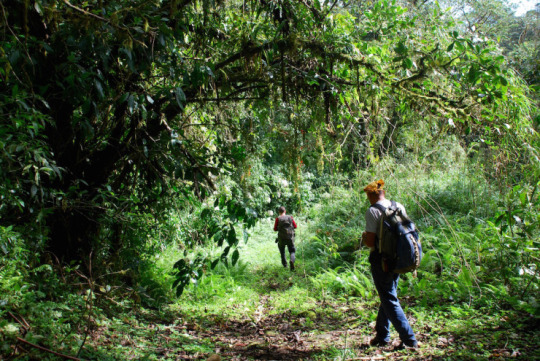
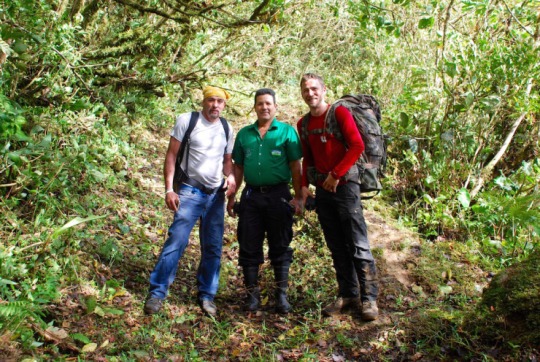



Refugio El Aleman, about 1.5 – 2 hours’ descent from the Monteverde Reserve into the Penas Blancas Valley. Though it’s nothing fancy to look at, the cabin’s dry wooden floors and sparsely equipped kitchen feel like a goldmine when you’re in need of a respite.

Café chorreado is a magical remedy for soggy feet.



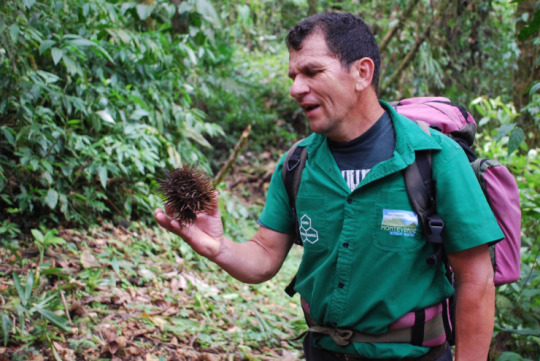
“Pico de mono.” That’s not the scientific name…heh heh.


“Refugio Eladio,” our final destination and lodging for the first night. The cabin is that of Eladio Cruz, who was the first Tico to sell his land to the Monteverde Conservation League and, in doing so, set an example for scores of landowners to follow.

Rice and beans will never taste as good as they do on the porch of Eladio’s.




The question of access
Through the years, admission to the valley has been slowly restricted, now excluding tourists and even a number of educational groups as well. In the present day, only a few recurring student groups and researchers are admitted to the valley – and these are accompanied by park personnel.
This restricted access is understandable, as this part of the Peñas Blancas territory is remote, wild, and unpredictable at times. Terciopelos are commonplace. Regular deluges make the already narrow, muddy trails unstable; the region is practically impassible during the rainy season. Combine the unpredictable terrain with the vast expanse of unpopulated territory, and you’ve guaranteed yourself a quagmire of liability if you allow just anyone in. If you are managing an enormous tract of land, with limited financial resources and limited personnel, why would you make the investment and undertake the risk of liability to open this area to the public?
This is a fine line, particularly when it comes to the land’s relationship with the local community. Some tico friends with whom I discussed this trip expressed discontent with the principle of having to (in their eyes) be chaperoned into this territory. Even old residents of the area – who have grown up foraying into the valley, either as park guards or as hunters in times past – are required to be accompanied by forest guards when they go into the area, which can generate feelings of distrust.
This raises an important question in conservation: how do you convince people of the need to protect a land if they are not allowed to see it or appreciate it firsthand? One of the most important purposes a reserve can serve is to educate. This is something that the reserves of the Monteverde area (the Monteverde Reserve, Children’s Eternal Rainforest, Santa Elena Reserve, etc.) do very well, and are continuing to improve on. By providing educational programming for members of local communities, residents take ownership and become allies, not antagonizers, of the conservation effort. It is a delicate balance deciding how much land to open for educational purposes, and how much should be left untouched so that it can, over time, be restored to its natural condition.

There is something so special about this valley. If it had a mouth, oh the stories it would tell. As we trekked back through the valley, from Eladio’s to El Aleman to the Monteverde Reserve, we passed through a clearing where a house had once stood. Now, perhaps 40 years later, there was barely a trace of where the foundation had been. Fern fronds, cecropia saplings, and other flora advanced steadily into the clearing, staking out their shares of unclaimed sunlight. As we walked, we passed through two rows of citrus trees, striking because of the even spacing between each pair. Among so much chaos, they seemed to be the only part of the clearing that had maintained their order. It was a powerful image – and a powerful reminder – to see “civilization” reclaimed by nature.
Read more…
“History of the Monteverde Conservation League and Children’s Eternal Rainforest” by Leslie Burlingame
“How a small town in Costa Rica is defining conservation for Central America” by Caitlin Lobby
The history of the the Peñas Blancas Valley and of the conservation movement in the Monteverde region is recounted in detail in Walking with Wolf by Kay Chornook. If you’re spending an extended time in the area, or simply are interested in Montverde’s unique conservationist past, I’d highly recommend this book.
0 notes
Text
Turn and face the strange.
Turn and face the strange.

Are you ready for yet another post in which I announce the complete overhaul of my geographic and cultural situation? Today is your day. I’ve held out on any sort of announcement, because change feels less permanent if fewer people know about it. But hello, here I am, not in Costa Rica anymore, and not writing about it doesn’t make it any less true. Now let’s dial back that tone of resignation…
View On WordPress
1 note
·
View note
Text
Growing up, I liked to climb trees. That little extra boost from the ground gave me the ability to spy on my siblings and (supposedly) impress the boys. To me, a few feet above the ground seemed a feat.
Now, meet my co-worker Ernest. Ernest really likes to climb trees. Ernest likes to climb trees so much that he is certified professional tree climber.
(Let me know if you knew that was a thing…because I did not.)
But Ernest doesn’t climb trees to spy on his siblings or impress boys; he uses this unique skill to perform scientific research in places you could never reach on tip-toe. In fact, he’s conducting one of the most extensive camera trapping projects in Central America, fastening cameras high in the cloud forest canopy to capture data on tree-dwelling mammals.
But for a day, Ernest decided to teach some more commonly-seen ground-dwelling mammals how to climb. And so five co-workers and I set out to defy gravity, if just for an afternoon, at the nearby Finca Ecologica San Luis.
Ernest showed us the ropes (literally), and it wasn’t long before we were dangling in the air, suspended between the canopy above and pasture below.
Stay tuned for whether or not Jose remembered how to tie the knot…
View from halfway to the half-way point
What goes up…
…must come down.
An entirely different landscape halfway up the tree
Color me impressed, because it’s been five days since my climb and my legs still don’t properly bend. Check out Ernest’s awesome work on his blog, and cross your fingers that I’ll be able to walk soon.
Abrazos,
Molly
Going vertical Growing up, I liked to climb trees. That little extra boost from the ground gave me the ability to spy on my siblings and (supposedly) impress the boys.
1 note
·
View note
Text
3:02 AM

No one takes you seriously when you write with a hot pink flamingo pen. They may not know what you are writing, but they know it is a farce. But though the pen gives me equal parts delight and shame, sometimes you are desperate and nothing but the flamingo pen will do. It is 3:02 AM, and like all respectable writing, this post is not being written with a pink flamingo pen (though my customs form…
View On WordPress
0 notes
Quote
Is there anything more beautiful in this life than two souls bound only by a hunger to see the extraordinary in each other?
vodkaisthatyou
(via wnq-writers)
4K notes
·
View notes
Quote
Humility isn’t thinking less of yourself, it’s thinking of yourself less.
C.S. Lewis
1 note
·
View note
Quote
The more I thought about it, [I was] even more embarrassed for my bluntly utilitarian culture. 'The way they tell it to us Anglos, God put the earth here for us to use, westward-ho. Like a special little playground...But where do you go when you've pissed in every corner of your playground?'
...To people who think of themselves as God's houseguests, American enterprise must seem arrogant beyond belief. Or stupid. A nation of amnesiacs, proceeding as if there were no other day but today. Assuming the land could also forget what had been done to it.
Animal Dreams by Barbara Kingsolver
1 note
·
View note
Photo



San Gerardo, Children’s Eternal Rainforest, Costa Rica.
0 notes
Quote
Human development is primarily about being more, not having more.
The Earth Charter
1 note
·
View note
Audio
Ella siempre temió echar raíces
que pudieran sus alas cortar
y en la jaula metida, la vida se le iba
y quiso sus fuerzas probar
(First heard in a wooden swing by by Lake Nicaragua)
2 notes
·
View notes
Photo


Waking up to Volcano Arenal. San Gerardo Biological Station, Bosque Eterno de Los Ninos, Costa Rica.
2 notes
·
View notes